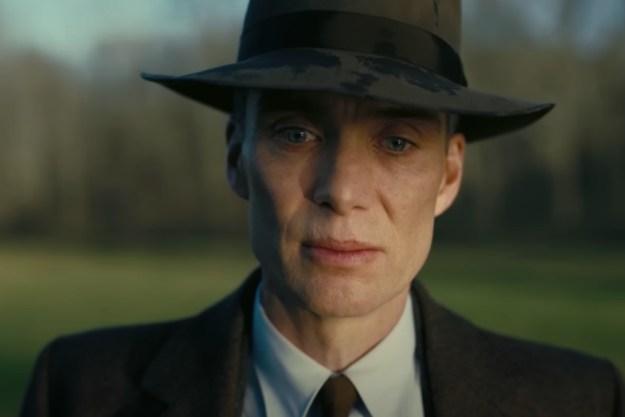If he’s known for one thing, Stephen King is the horror guy. He’s the author who wrote Carrie, or It, or The Shining, or any other work you can think of that seems designed to burrow deep into your psyche and discover what scares you most. King is really good at it, too, whether you’re more familiar with the books he’s written or the movies almost all of them have been turned into.
What’s core to King’s appeal, though, is that his stories embrace the schlock that is the cornerstone of the horror genre. Christine is a story about a killer car, and while it’s also about teenage isolation and a general feeling of purposelessness, it’s also very much just about a car that tries to kill people on behalf of its owner. King has never shied away from the pulp inherent in the conceits of his stories, and he recognizes that his readers are so loyal in part because his books are entertaining in addition to whatever hidden meanings they might convey. He grew up reading pulpy paperbacks, and he’s just brought his own stylish prose to that same material.
Defenses of King’s work, and arguments about whether or not his stories qualify as “literature,” have been roiling for years now. Of course, designations like that ultimately lie, to some extent, in the eye of the beholder, but there is an undeniably concerted craft in the way that King wrings terror out of his audience. He takes familiar settings, and specifically the world of comfortable white suburbia, and unveils the darkness hidden just beneath the surface. It’s not Blue Velvet, but it’s not pure drivel either.
King’s best movie adaptations take pulpy ideas seriously

The best movies adapted from King’s work know how to take a pulpy approach to his stories that nevertheless takes them seriously. In effect, the best King adaptations marry his high-minded ideals with his more basic instincts. That’s the combination that made King into a populist phenomenon, and translating it to the big screen is no small feat.
King may have had his issues with Stanley Kubrick’s adaptation of The Shining, but that movie knows that it can be both horrifying and silly at the same time. Jack Nicholson’s central performance is wild-eyed and manic, and you’re not exactly shocked when it turns out that he wants to murder his family.
“Here’s Johnny!” has become iconic not only because it’s terrifying, but also because Nicholson knows that the moment is campy too. He’s taken an ax to the door where his wife and son are hiding, and he spends the final third of the movie limping around the Overlook Hotel and grunting like a feral beast. It’s a wonderful performance, and perfectly in keeping with the kind of over-the-top madness that King so expertly builds to throughout his books.
Misery is another great example — Kathy Bates is working in a similar register to Jack Nicholson, and manages to achieve a similar effect. She’s a caricature, but one that Bates is able to infuse with humanity in large part because of her own skills as a performer. Annie may be volatile, but she’s someone we come to understand in spite of her cartoonishness, and she becomes an object of fear even as her humanity remains at least partially recognizable.
The simpler, the better

Even outside of the realms of horror, the most widely acclaimed King adaptations have a certain level of hokey wholesomeness to them. The Shawshank Redemption, for example, is remarkably solid movie that gets a lot of grief because it is, for some strange reason, the top-ranked movie by users on IMDb. When you really think about it, though, it’s not a shock that Shawshank tops that list. It’s a touching portrait of a male friendship that, while well told, is not digging too far beneath the surface.
The movie’s protagonist is an uncomplicated hero, and his belief is a simple one — that even in the most dire circumstances, hope is essential to survival. That idea is, if not pulpy, not incredibly complex or singular either. But director Frank Darabont, in embracing that idea with reservation, crafts a story that speaks to a lot of people. He’s taking a page right out of one of King’s many, many novels. Shawshank is a pretty straightforward example of King’s populism translating to the big screen.
Stand By Me works the same way. It’s a story told by an adult narrator about a dark adventure he had as a child, and the reason it works is because it’s a movie about childhood nostalgia made for adults. Similar to Shawshank, the emotions here are big and unsubtle. Youth was a time of uncomplicated happiness, and adulthood slowly wears away at that until all you have left are your memories.
King adaptations are art, even if they aren’t always revelatory

There is truth behind the ideas in King’s work, whether his story is one of a man driven mad by isolation and unfulfillment or one about childhood slowly fading away. What his best adaptations recognize, though, is that King’s ideas are meant to play to an enormous audience. He’s an accessible writer, and the movies that understand that best are the ones which transform his material into totally accessible movies.
None of this is to say that adaptations of King’s work do not contain incredible artistry. The Shining may be the most obvious example of this, but Rob Reiner also directed two totally different King adaptations that both have plenty of craft behind them. What these movies recognize, though, is that King believes in true populism, and in making his novels interesting to as many people as possible.
Fans of high art also pick up King’s books on occasion, but there are also people who read King who aren’t interested in “literature” more generally. By the same token, the adaptations of King’s work that tend to fare the best are the ones that try to demolish the distinction between low and high art. As Ethan Hawke said in a recent viral interview clip, “there are movies that people put their hearts into, and there are movies that people try to cash in on.” King’s best adaptations have plenty of heart, and funnily enough, many of them also made a fair chunk of change. That’s the genius of Stephen King: He can straddle the line between commerce and art, and imbue pop art with soul and intelligence that few authors, and fewer literary adaptations, possess.
Editors' Recommendations
- Forget Netflix and chill: This is the best streaming service for binge watching on weekends
- Is the MonsterVerse the best bad movie franchise ever made?
- Max celebrates Women’s History Month with tons of movies, TV shows, and original programming
- Furiosa: Why the Mad Max prequel is the most anticipated 2024 action movie
- 10 best sci-fi movies of 2023, ranked




